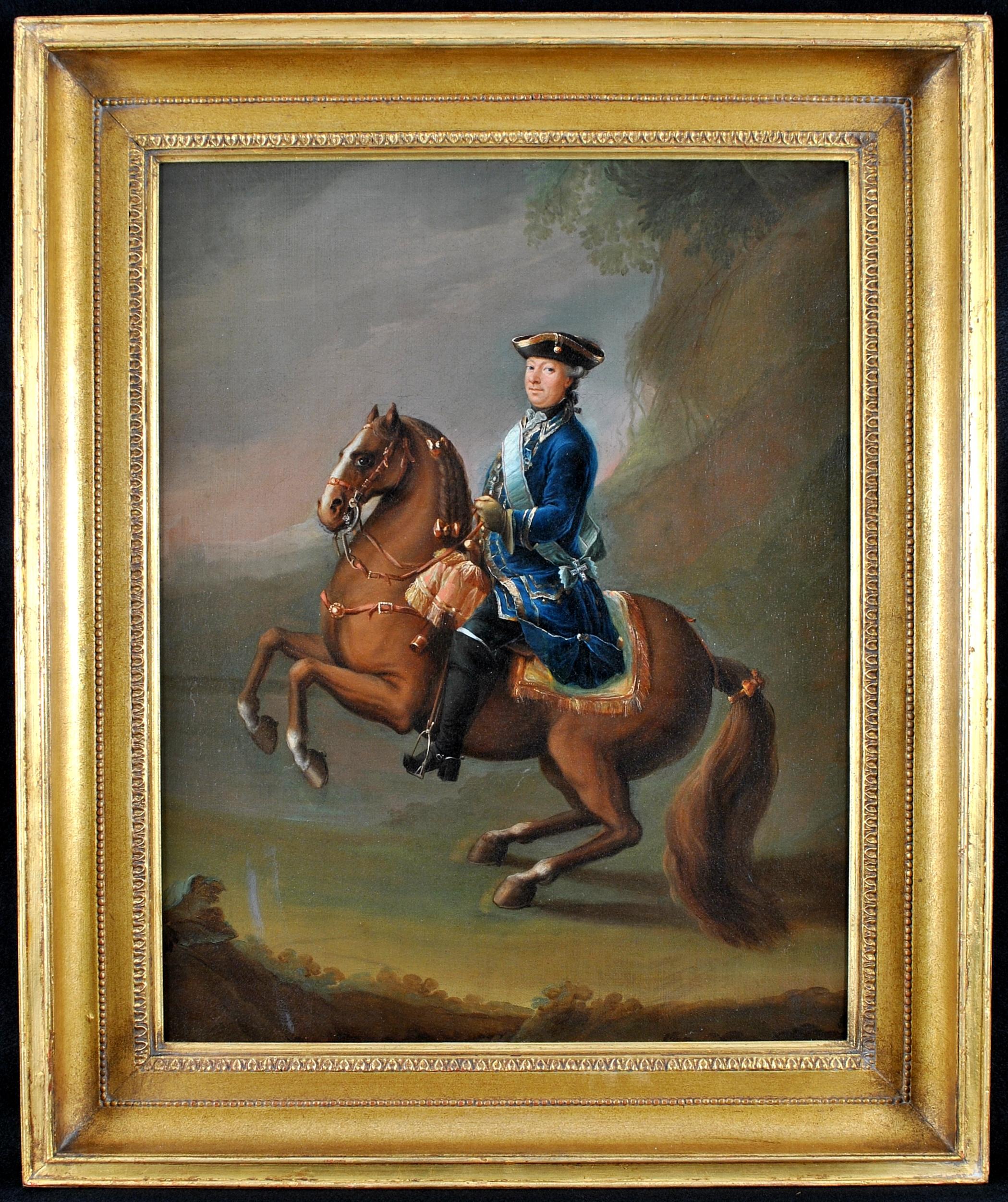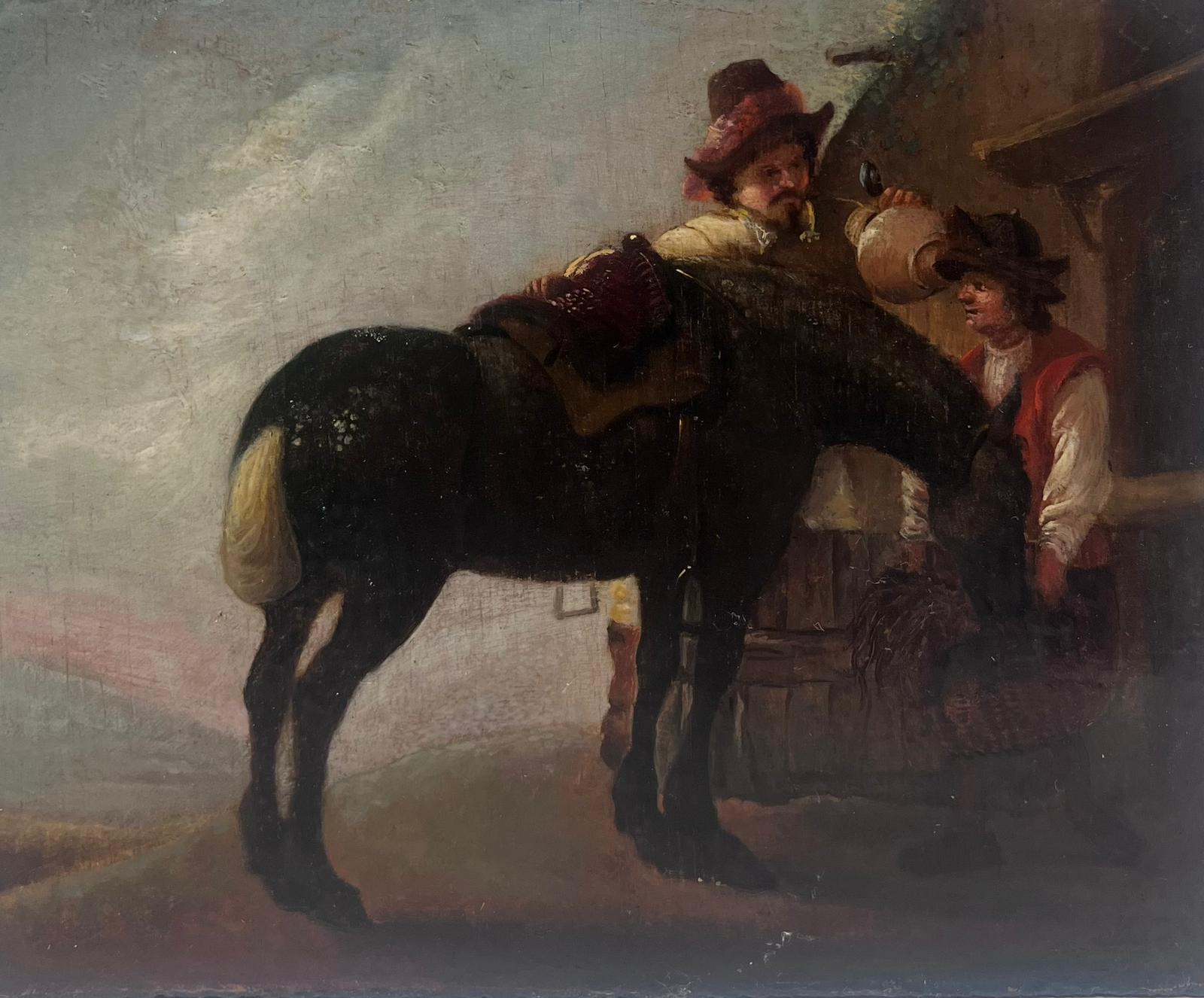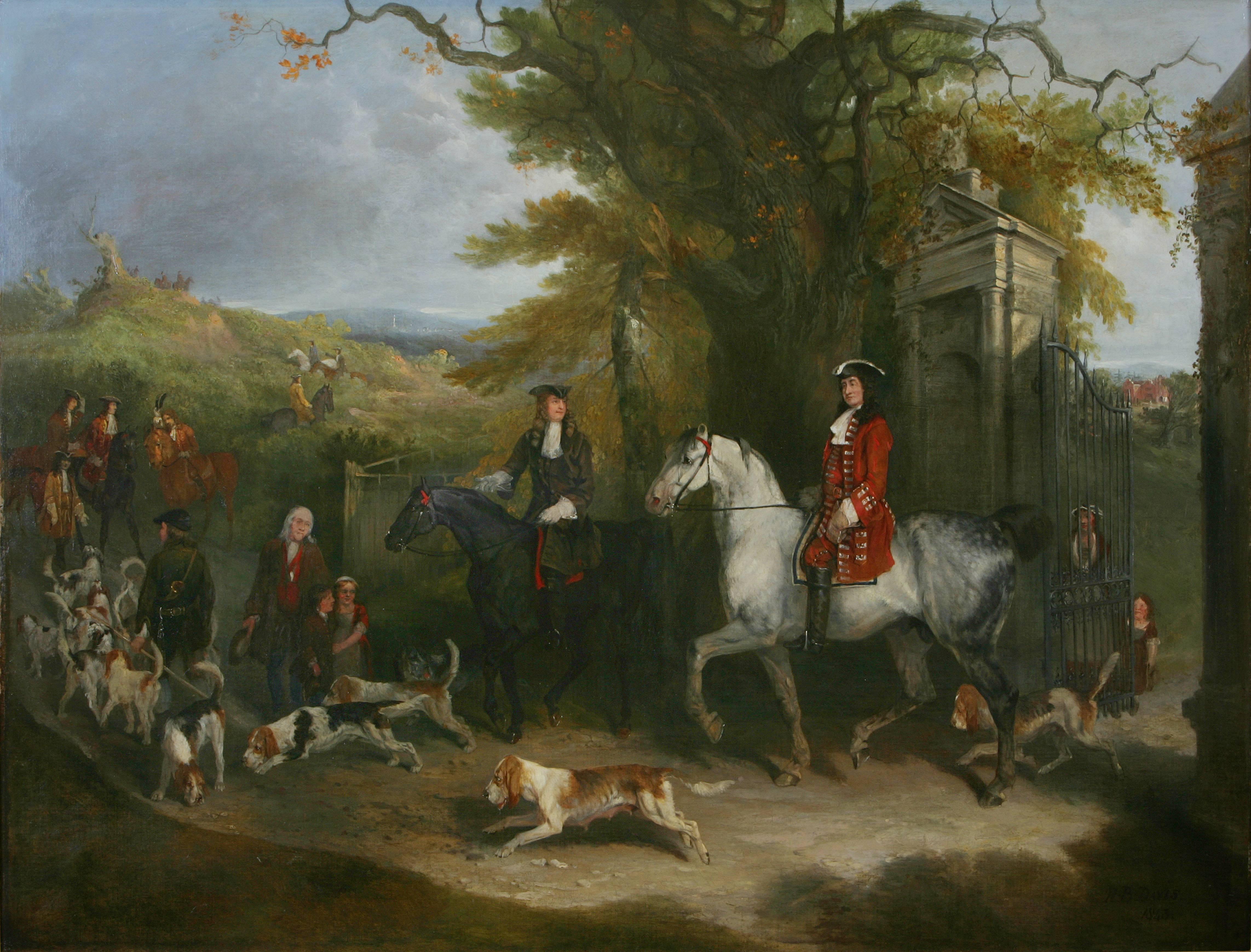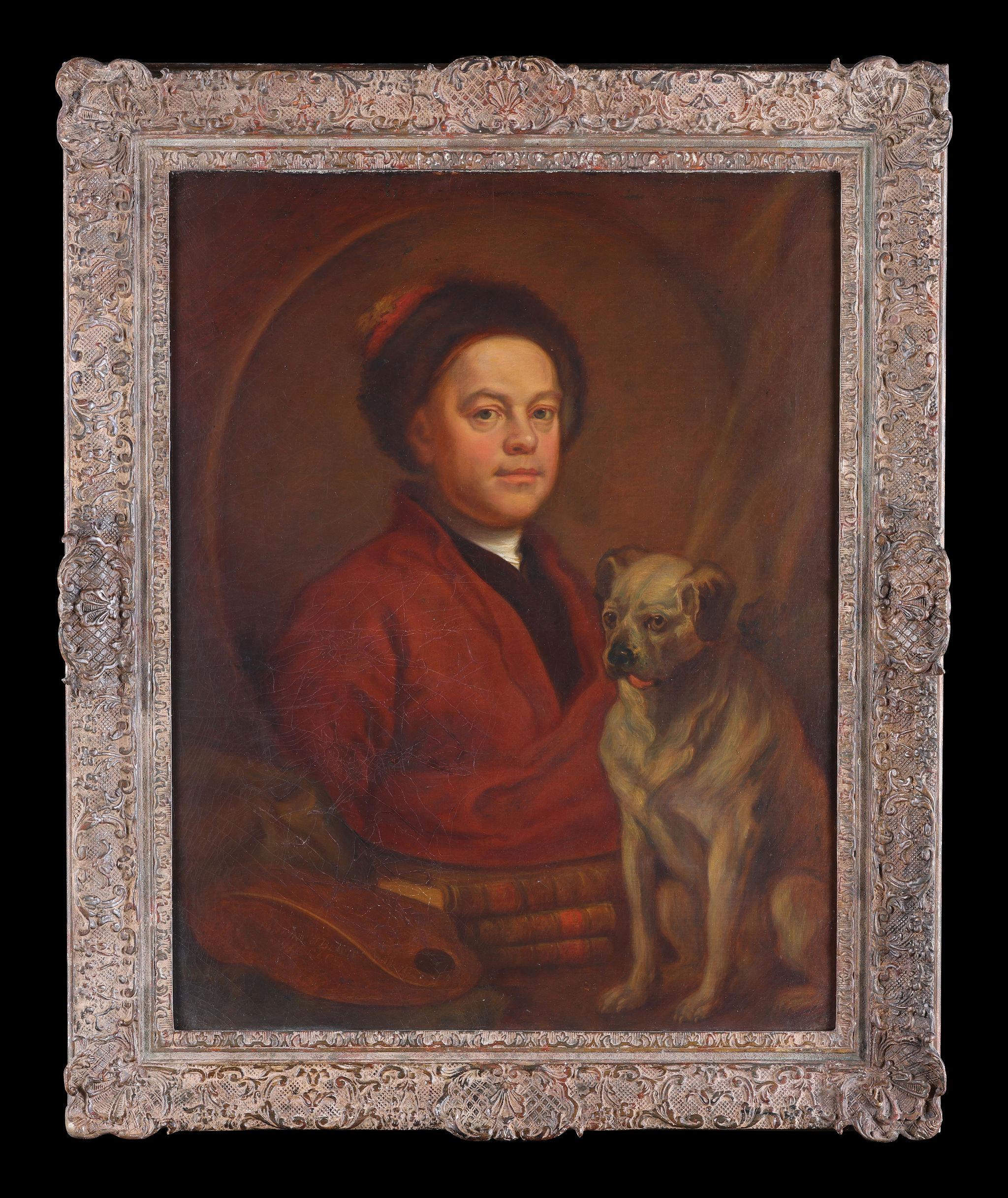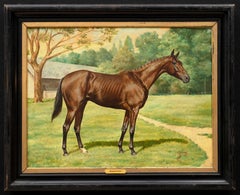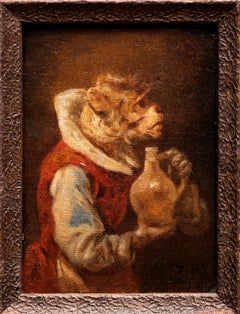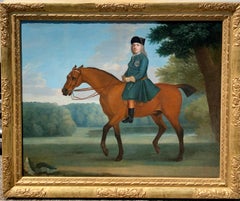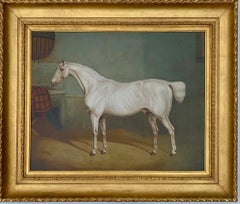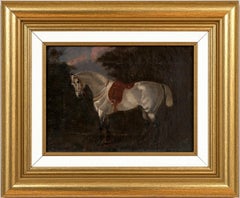
Horse Portrait "Shamrock" (British School, 19th Century) Oil Painting on Canvas
Want more images or videos?
Request additional images or videos from the seller
1 of 6
UnknownHorse Portrait "Shamrock" (British School, 19th Century) Oil Painting on Canvas
About the Item
- Dimensions:Height: 9 in (22.86 cm)Width: 6.75 in (17.15 cm)Depth: 2 in (5.08 cm)
- Medium:
- Movement & Style:
- Period:
- Condition:This is painting is untouched though shows well. There are minor stretcher marks but it's been left alone as it has wonderful age. The brushwork is open and loose and looks immediate and naturalistic. The frame is new.
- Gallery Location:SANTA FE, NM
- Reference Number:1stDibs: LU140826719692
About the Seller
5.0
Platinum Seller
These expertly vetted sellers are 1stDibs' most experienced sellers and are rated highest by our customers.
Established in 1995
1stDibs seller since 2020
Typical response time: 1 hour
More From This SellerView All
- Antique Dog Painting; Cavalier King Charles Gustav Lorincz (Austrian, 1855-1931)Located in SANTA FE, NMAntique Dog Painting of a Cavalier King Charles Gustav Lorincz (Austrian, 1855-1931) Oil on panel, signed 9 1/4 x 6 3/4 (13 3/4 x 11 1/4 frame) inches Gustav Lorincz was a noted painter of animal subjects, mostly portraiture of dogs and cats...Category
Early 1900s Realist Animal Paintings
MaterialsCanvas, Oil
- Antique Horse Portrait- "Sysonby, " Edward Herbert Miner. ex Sotheby's 2004By Edward Herbert MinerLocated in SANTA FE, NMAntique Horse Painting "Sysonby"-Equestrian Painting Edward Herbert Miner (American, 1882-1941) Depicting the champion thoroughbred horse Sysonby (1902-1906) Oil on canvas, signed "E H Miner 1905" 24 x 32 inches Ex. Collection of Mr. & Mrs. Walter M Jeffords, a prominent Philadelphia lawyer and racehorse owner, at Sotheby's NY, 2004. Sysonby (1902–1906) was an American Thoroughbred racehorse. He won every start easily, except one, at distances from one mile to two and a quarter miles. His superiority as a two and three-year-old was unchallenged during his short career of 15 race starts. Sysonby was regarded by many experts as the best horse to have raced in the United States between the Civil War and World War I. His sole loss in 15 starts came after he was doped by his groom as a bribe; even then, it took another member of the Hall of Fame, Artful, to beat him Foaled in Kentucky, Sysonby was a bay son of the 1885 Epsom Derby winner, Melton, out of the English mare Optime by Orme (by the undefeated Ormonde). The mating of Melton and Optime was arranged by Marcus Daly, who was involved with the Anaconda Copper Mine. Daly died before Optime, stabled in England, foaled. His stock, including the still pregnant Optime, was brought to New York to be auctioned. James R. Keene purchased Optime for $6,600, sending her to his Castleton Stud in Kentucky, which he rarely visited. Apparently Optime's foal, observed in his paddock, was anything but inspiring. Considered unattractive and small, as well as slow, young Sysonby was to be sent back to England for sale. But Keene's trainer, the well-regarded James G. Rowe, Sr., had seen Sysonby in action during some early trials. When it was time for the yearlings to be sent away, Rowe, a leading trainer who had once been a leading jockey (guiding Harry Bassett to his Saratoga Cup win amongst many other successes), covered Sysonby in blankets, convincing Keene he was too ill to make the long ocean journey. In the care of Rowe, Sysonby won everything Rowe entered him in by sizable margins, with the exception of the Futurity Stakes (USA), where he came in an unaccountable third, beaten by the filly Tradition and the filly Artful. Artful ranked 94th in the top 100 U.S. Thoroughbred champions of the 20th century by Blood-Horse magazine). Rowe saw Sysonby's groom exhibiting a large sum of money, and the groom admitted he'd been bribed to drug Sysonby before the race. If not drugged, nothing beat Sysonby. The turf writer Neil Newman ranked Sysonby as one of the three best colts he'd ever seen. The other two were Colin (also trained by Rowe) and Man o' War. Sysonby was the top money earner of 1905. Average winning margin was 4 ¼ lengths. Was ahead at every point of every race, except at the quarter call in the Brighton Junior Stakes, and in the stretch of the Futurity. Sysonby was inducted into the National Museum of Racing and Hall of Fame in Saratoga Springs, New York, in 1956. In the list of the top 100 U.S. Thoroughbred champions of the 20th Century by Blood-Horse magazine, he ranks 30th. Eighteen years after Sysonby's death, a December 11, 1924 Daily Racing Form article looking back on his racing career, called Sysonby "One of Greatest Race Horses in History of the American Turf". James Rowe, Sr. was also inducted posthumously into the Hall of Fame as a trainer. Provenance: Walter Morrison Jeffords Sr. (August 8, 1883 – September 28, 1960) was a successful Investment banker and owner/breeder of Thoroughbred racehorses who, in partnership with his wife's uncle, Samuel Riddle, purchased and operated Faraway Farm near Lexington Kentucky where they stood Man o' War. Jeffords is one of only five people to be named an Exemplar of Racing by the National Museum of Racing and Hall of Fame. His former estate is now Ridley Creek...Category
Early 1900s American Realist Animal Paintings
MaterialsCanvas, Oil
- Portrait of a Monkey with Wine Jug, Zacharias Noterman (Bel. Fr. 1824-1890)By Zacharias NotermanLocated in SANTA FE, NMPortrait of a Monkey with Wine Jug Zacharias Noterman (Belgium & France 1824-1890) Initialed "Z N" l.r. Oil on board 8 x 6 inches PROVENANCE: Galerie Tamenaga, Paris (label verso); Louvre des Antiquaires, Paris; Berman Swarttz, Los Angeles, California, Marcella Swarttz, Beverly Hills, California 8 x 6 inches Zacharias Notermann (1820 in Ghent – 1890 in Paris) was a Belgian painter and printmaker who specialized in scenes with monkeys engaging in human activities (the so-called singeries), as well as in paintings of dogs. He also produced images and scenes of traveling circuses. Zacharias Noterman was born in Ghent in the family as the son of an artist-decorator. He was originally trained by his older brother Emmanuel Noterman, genre and animal painter active in Antwerp. Noterman continued his art education at the Academy of fine arts Antwerp. Zacharie Noterman...Category
Mid-19th Century Realist Animal Paintings
MaterialsCanvas, Oil, Board
$7,920 Sale Price20% Off - Antique Horse Painting "Standing Grey Horse, Facing Right" Georg Wolf dated 1907Located in SANTA FE, NMAntique Horse Painting “Standing Grey Horse, Facing Right” Georg Wolf (Germany 1882-1962) Oil on canvas Signed and dated 1907 lower right 27 x 19 (35 x 27 frame) inches With it's bobbed tail cut short so it doesn't become tangled, it's apparent that this fine specimen was a draught horse...Category
Early 20th Century Post-Impressionist Animal Paintings
MaterialsOil, Canvas
- Antique Dog Painting of a Terrier- "The Shah" George Earl (England, 1824-1908)By George EarlLocated in SANTA FE, NMAntique Dog Painting of a Terrier: “The Shah” George Earl (England, 1824-1908) Circa 1870 Oil on canvas. 12 ¾ x 12 ¾ (21 x 21 frame) inches. Orig...Category
1860s Realist Animal Paintings
MaterialsCanvas, Oil
- Antique Cat Painting "Cat with Butterfly in a Meadow" Arthur Heyer 1872-1931By Arthur HeyerLocated in SANTA FE, NMAntique Cat Painting "Cat with Butterfly in a Meadow" Arthur Heyer 1872-1931 Oil on canvas Signed lower right "Heyer A." 25 1/2 x 21 (29 1/4 x 3...Category
Early 1900s Realist Animal Paintings
MaterialsCanvas, Oil
You May Also Like
- 18th century English portrait of the Duke of Newcastle upon his horse inBy Thomas SpencerLocated in Woodbury, CTThomas Spencer was a leading sporting and equestrian artist of the period of John Wootton and James Seymour; his art shows a considerable to debt to tha...Category
1760s Old Masters Portrait Paintings
MaterialsCanvas, Oil
$54,800 Sale Price20% OffFree Shipping - 19th century English portrait of a White/grey hunter in a stableBy Charles TowneLocated in Woodbury, CTEnglish 19th century portrait of a White / Grey hunter in a stable. Charles Towne was born in Wigan in 1763. He was trained as a coach painter, and by ...Category
1820s Old Masters Animal Paintings
MaterialsOil, Canvas
$19,600 Sale Price20% OffFree Shipping - Italian Greyhound and Friends - Italian 17thC Old Master dog art oil paintingBy Francesco FieravinoLocated in London, GBThis stunning Old Master 17th century oil portrait painting is attributed to Francesco Fieravino, an artist famous in his day for still lifes and carpets. This painting which dates t...Category
17th Century Old Masters Animal Paintings
MaterialsCanvas, Oil
- Portrait of Julien Prieur as a hunter - Circle of Jean-Baptiste Oudry 1686-1755By Jean-Baptiste OudryLocated in PARIS, FRThis portrait depicts us the trusted confidant of the Conflans d'Armentières family. More precisely, Julien Prieur was the fiscal procurator of the Marquisate of Armentières, playing the role of representative of the "public ministry", safeguarding the interests of his lord. His role, one can imagine, was crucial at the death of Michel de Conflans (in 1717) since the latter left an heir, Louis, aged only 6, and a widow, Diane Gabrielle de Jussac, whom some memoirs describe as "a very clever grande dame" . Prieur ensured the smooth running of the family's affairs and it is probably to thank him for his services that Diane Gabrielle had his portrait painted, most probably by a painter close to Jean-Baptiste Oudry. Julien Prieur appears as he is, middle-aged, with a benevolent look, in his hunting suit. Only his knotted wig links him to the nobility. Above all, he is depicted as a hunter, a passion that he shared with the Marquis of Armentières. His very young master, Louis, became a first-rate hunter, hunting in the King's entourage, in whose cabinet he died of apoplexy in January 1774. As for the his son, he was one of Louis XVI's closest hunting companions, as numerous souvenirs attest . 1. Some biographical information about the model and the commissioner While the identity of many 18th century portraits is uncertain, an old label stuck on the reverse of the canvas gives us some precise information on the identity of the model: "Mr. Julien Prieur, homme d’affaires de Mr. le Marquis d'Armentières - Commune of Brécy - Aisne". The label also suggests that it could be his son Louis Prieur living in Rocourt (probably Rocourt-Saint-Martin, a neighbouring municipality of Brécy), born on 30 September 1745, who died on 8 July 1826, but this hypothesis must be rejected in view of the model's clothing. This label probably gives us an indication on the previous owner the owner of this painting; we will see later why it seems likely that this label was affixed between 1826 and 1832. Brécy is now a municipality in the Aisne County (Hauts-de-France) located between Soissons and Château-Thierry, slightly north of the Paris-Reims axis. It borders the municipalities of Armentières-sur-Ourcq and Rocourt-Saint-Martin. According to Louis Prieur's death certificate, he was in fact born in 1743 and not in 1745 . The age of the model in the painting and the dating of this painting would indicate that Julien Prieur, was probably born at the very end of the 17th century. In Louise-Marthe de Conflans-Coigny, chatelaine de Brécy , we read that "the Conflans were a family of ancient nobility, which genealogists trace back to the 12th century, when it was said to have come from the house of Brienne. In the 16th and 17th centuries, this family had several illustrations in the profession of arms. [...] Michel de Conflans, [...] belonged to a younger branch of the family, of which Saint-Simon wrote, with his acid soaked pen, that "poor and obscure, they had never left their village, where their house resembled a hut" and elsewhere that they "lived on their rifles and cabbages". Fortunately for Michel de Conflans, the last representative of the elder branch, Henriette d'Armentières, made him her heir on her death in 1712. It was through her that the land of Armentières and its 14th century castle became part of the estate of this branch, as well as, not far from there, the land of Brécy and the castle of Le Buisson, where the family lived. In the early years of the 18th century, Michel de Conflans was able to push himself into the entourage of the Duke of Orleans, becoming his first gentleman of the chamber. However it was above all his son Louis who restored the family status through his military career. Born on 23 February 1711, Louis de Conflans, Marquis d'Armentières died of apoplexy on 18 January 1774, in the King's cabinet at Versailles. Appointed lieutenant general in 1746, he received his Marshal of France’s stick in 1768. The Dictionary of French Biography writes of him that "without ever achieving a high command, he appeared with honour in all the wars of his time". The estates of Armentières and Le Buisson were sequestered during the French Revolution, declared national property and sold at auction (in 1794 and 1795 respectively) after the Marquise d'Armentières, the Marshal's second wife, was beheaded in 1794. The Château du Buisson (where Michel de Conflans died in 1717) was bought by a granddaughter of the Marshal de Conflans, the Marquise de Coigny, in 1816 and remained in her family after her death in 1832 until the sale of the 1,054 hectares estate in 1866. The bayonet blows that probably pierced the canvas in three places may well have a revolutionary origin and it is conceivable that the painting, acquired by the Marquise de Coigny from Louis Prieur, Julien's son, after the latter's death, was then restored and given the label specifying the name of the model. 2. Description of the portrait The painting presents a man in his thirties in his hunting costume. Pictured at mid-body, his face is marked by his life in the open air and characterised by a look of great bonhomie. Holding a rifle under his elbow, he is soberly dressed in a large caramel-coloured jacket, decorated with silver buttons. Presented in a three-quarter view, the model holds a partridge in his right hand. The jacket opens onto a vermilion waistcoat. A green shoulder strap probably holds a powder flask hidden under his arm while a satchel is visible on his belt. The model is wearing a grey wig, tied at the back with a black ribbon that seems to fly in the wind. This ornament anchors Julien Prieur in his time. "The new King of France, Louis XV, [imposed] a style of smaller wigs for men and the rigorous white or preferably greyish powdering. From the middle of the century men also used a ponytail on the back of the neck, tied with a ribbon, a style that became very popular in all courts." He stands out against a dark, purplish sky at the end of an autumn day in a soberly sketched forest landscape. The treatment of the sky recalls the influence of Largillière, Oudry's first master. 3. Jean-Baptiste Oudry Jean-Baptiste Oudry was born on 17 March 1686 in Paris, rue de la Ferronnerie. He began his apprenticeship around 1705-1707 with Nicolas de Largillière, with whom he stayed for five years. In 1713 Oudry established his "livre de raison" in which he reproduced all his early works in wash drawings up until 1718. During this first period which lasted about 7 years, Oudry produced works of great diversity, both in the genres that the artist tackled and in the artists which influenced him. It has been estimated that he painted about 150 pictures during this period: mainly portraits, but also still lifes and some religious paintings and landscapes. Of the hundred or so portraits that Oudry is said to have painted during this period, only fifteen have been identified today. A number of those lost portraits are probably still confused with works by Largillière. First admitted to the Académie de Saint-Luc in 1708, he was then allowed to join the Académie Royale in 1717, and subsequently admitted as a history painter in 1719. This year marks a turning point from which Oudry will assert himself as an animal painter. In 1723 he met Louis Fagon, Intendant of Finances, and the Marquis de Beringhen, the King's first equerry, who became both friends and patrons of the artist, giving him access to royal commissions and enabling him to be appointed as painter of the Royal Tapestry Factory of Beauvais in 1726. From 1728 onwards, the creation of tapestries became the core of his work, even though at the same time Oudry developed his skill as an illustrator, first for Scarron's Roman Comique and then for La Fontaine’s Fables. Between 1726 and 1731, Oudry created the decoration of a large drawing room at the château de Condé-en-Brie, about twenty kilometres from Brécy, which has remained in place to this day. This important commission, about which few details are known, is said to have originated with the Countess de Verrüe, a great lady of the French Regency who often stayed at Condé with her friend Jean-François Leriget, Marquis de la Faye, then owner of Condé. A prolific artist, Oudry fulfilled numerous commissions in parallel with his regular contributions to the Salons, to which he regularly took part until 1753. He suffered a stroke in 1754 and died the following year. It seems almost certain, in view of the importance of his work, that Oudry supervised a workshop in which several artists were involved, but this point is very poorly documented. Given the geographical proximity of Brécy and Condé-en-Brie, the links between the Armentières family and the Condé patrons, and finally based upon the quality of our portrait, we propose the hypothesis that it was painted by one of the painters who worked with Oudry at Condé. 4. Related artworks: comparison with some other portraits of hunters by Jean-Baptiste Oudry While Oudry gradually abandoned portraiture from 1720 onwards to devote himself to animal paintings, he seems to have made an exception for hunter portraits, which were often depicted in the company of their hunting dogs. Two examples seem particularly evocative and suggest a dating for our painting around 1730. We will see in a second part why this dating proposal seems relevant. The first portrait worth mentioning is the presumed portrait of Lieutenant Claude-André Courtin de Crouey, lord of Quatre Fils and Cormeilles-en-Parisis made in 1723, reproduced below. Also presented in a very tight frame, it is interesting for the similarities in the representation of the rifle, and in particular the two metal rivets that are almost identical in our painting. The painting that seems closest to ours is the presumed portrait of Monsieur...Category
1730s Old Masters Portrait Paintings
MaterialsCanvas, Oil
- Horse & Rider in a Landscape - 18th Century French Old Master Portrait PaintingLocated in Sevenoaks, GBA beautiful mid 18th century French Old Master oil on canvas depicting a horse and well dressed rider in a clearing. Excellent quality and condition work, indistinctly inscribed on t...Category
18th Century Old Masters Portrait Paintings
MaterialsCanvas, Oil
- C19th Portrait Princesse de Joinville of Brazil - Spectacular fit for a palaceBy Henri d'Ainecy MontpezatLocated in London, GBPortrait of Princess de Joinville riding a Bay Horse Henri d’Aincy, Le Comte Monpezat (French 1817-1859) Painted circa 1837-9 oil on canvas 113 x 92 inches (including frame) 92 x 70 inches (unframed) Provenance – from a private royal collection This magnificent portrait depicts Princess de Joinville, the daughter of Pedro I, Emperor of Brazil and the King of Portugal. Through her illustrious family she was directly related Alexander III and Nicholas II of Russia and the Russian royal family, as well as to many of the great ruling families of Europe. The work clearly confirms Monpezat as one of the most accomplished equestrian portrait painters in France in the early nineteenth century. In terms of scale, quality and dramatic power, it must surely be considered amongst his finest works. The stance of the powerful thoroughbred - in half rear - emphasises the calm nature and courage of the Princess. Francisca of Brazil (1824-98) married a son of Louis Philippe I, the King of the French, and had three children. Born at the Imperial Palace of Saint Christopher, her youngest brother was the future Pedro II...Category
1830s Old Masters Portrait Paintings
MaterialsOil
Recently Viewed
View AllMore Ways To Browse
Unknown 19th Century European School
Antique Horse Tools
English Painting Of Horse
Hound Art
Horse Dog
Hunt Scene Painting
17th Century French Landscape
White Cat Painting
Rabbit Hunt Painting
Used Hummingbird
Horse And Dog
Slonem Rabbit
Acrylic Cat
Horse Oil White
Hunt Slonem Rabbit
Hawaiian House
Russian Navy
Animals On Linen




